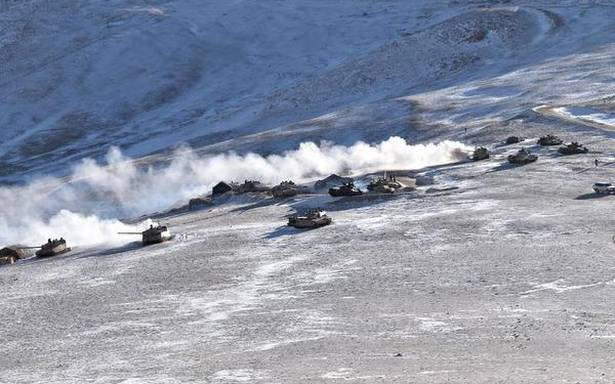
|
Getting your Trinity Audio player ready...
|
Things seem to be looking up for India in the neighbourhood. China has withdrawn its troops in eastern Ladakh across the Line of Actual Control (LAC). Pakistan has voluntarily come forward for a ceasefire across the Line of Control (LoC). The new U.S. administration has been issuing positive statements.
Shift in strategy
This is the second time in the last few years that China has been forced to make a reassessment of its ground strategy. Earlier in 2017, at Doklam where there was a 72-day stand-off, mobilisation of Indian forces led to the withdrawal of Chinese equipment and troops from the disputed area. It took almost 10 months for this to happen in Ladakh. It began at Pangong Tso; Depsang Plains and Hot Springs are yet to see the withdrawal.
This can be attributed to a conspicuous shift in India’s strategy. Prior to 2014, India used to engage in diplomacy and close matters through a quiet give and take in such conflicts along the LAC. In 2013, India was allegedly forced to dismantle some military structures as a part of the resolution process when China encroached into Depsang Valley. Indian troops used to generally avoid a face-off. That was the kind of peace we managed to maintain along the LAC.
But under the new policy, the Indian forces practice active engagement on the ground while their leadership engages in negotiations with their counterparts. This revised strategy of ‘proactive diplomacy together with strong ground posturing’ seems to be working well with our northern neighbour. Long ago, Chairman Mao Zedong had conveyed an important message to India through his Premier, Zhou Enlai. In August 1962, Mao had asked his army commanders to prepare for war with India. Zhou, a good friend of Prime Minister Jawaharlal Nehru, reminded Mao about the Panchsheel Treaty signed by the two countries, which mandated ‘peaceful coexistence’ as the core principle. Mao told Zhou to convey to Nehru that India and China should practice ‘armed coexistence’. This must always be remembered in dealings across the LAC.
The LoC too has seen some pleasant manoeuvres. In a sudden development, the Director Generals of Military Operations (DGsMO) of India and Pakistan decided on February 22 to strictly implement the 2003 ceasefire agreement. Coming after one of the worst years of ceasefire violations across the LoC (more than 5,000) and just before summer, this decision must be a greatly reassuring one for peace. On its part, India has always demonstrated its commitment to peace. A similar agreement was reached between the two DGsMO in 2018 too. However, there were violations by Pakistan, including the Pulwama attack. Pakistan Prime Minister Imran Khan insisted that there would be no engagement with India until the status quo was restored in Jammu and Kashmir. All that seems passe now. There seems to be equal enthusiasm in Pakistan over the ceasefire.
Just as China’s withdrawal cannot be second-guessed, Pakistan’s climbdown too cannot be explained conclusively. The FATF sword is still hanging over Pakistan’s head, the economy is in precarious condition, COVID-19 has impacted exports, and there is a repayment crisis. China is helping its friend, but it looks unhappy about the uncertainty over the China-Pakistan Economic Corridor.
Political pundits predict that when besieged from all sides, Pakistan has a propensity to spread terror and violence in India. India has enough experiences to appreciate Pakistan’s potential for mischief. That is why India has reiterated that there will be no let-up in counter-terror operations. But there is discernible change in General Qamar Javed Bajwa’s tone and tenor. Moeed Yusuf, Special Adviser on National Security in Pakistan, cryptically told journalists: “Do you think this could happen without pressure?”
Biden administration’s approach
Pakistan must be under pressure from India, the new U.S. administration as well as China. There are indications that the Biden administration will adopt a nuanced approach with China. In its own economic and strategic interest, China would prefer to give that a chance. It probably wants Pakistan also to fall in line. Contrary to fears, the Biden administration seems to be largely siding with India in its South Asia policy. “We are concerned by Beijing’s pattern of ongoing attempts to intimidate its neighbours. As always, we will stand with friends, we will stand with partners, we will stand with allies,” a State Department official stated recently on the border stand-off. In another statement, the U.S. State Department said it “welcomes” the steps taken to return Jammu and Kashmir to “full economic and political normalcy consistent with India’s democratic values”.
India should seize this opportune moment. Taking a leaf out of Vajpayee’s statesmanship in 2003 may not be a bad idea.
(The article was originally published in The Hindu newspaper on 11 March, 2021. Views expressed are personal.)




Dear Sir,
We as a common Indian can easily feel the direct and indirect changes, what India has achieved in last six years under the leadership of our Hon’ble Prim Minister Modi Jee. Now the whole world is taking India as a nation seriously, honoring its overall strength and accepting the huge potential of Indian nationals. It is all because of strong willpower of Indian leadership. By its several decisions, Modi Jee has redefined the nationalism and therefore China, Pakistan and several other external/internal enemies are compelled to change their behavior.
“क्षमा शोभती उस भुजंग को
जिसके पास गरल हो
उसको क्या जो दंतहीन
विषरहित, विनीत, सरल हो।” ___रामधारी सिंह ‘दिनकर’